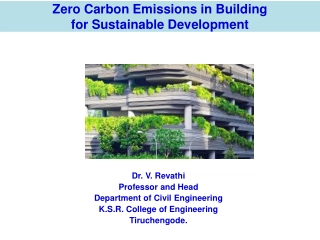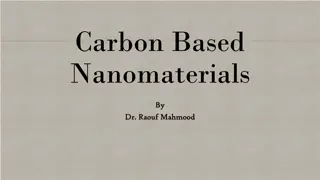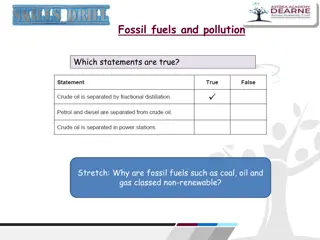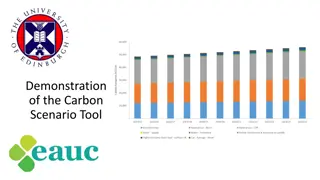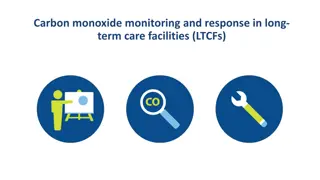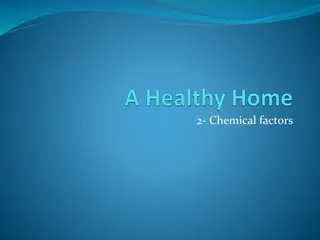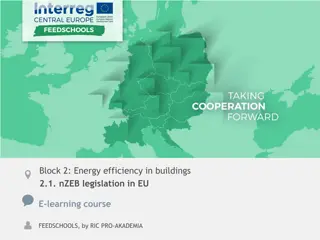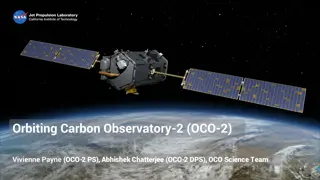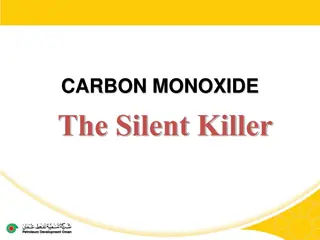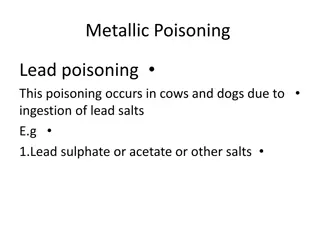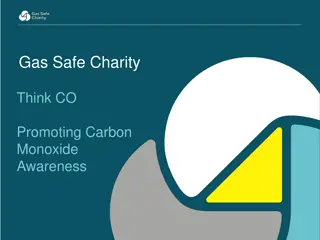Protecting Against Carbon Monoxide Poisoning in Buildings
Carbon monoxide (CO) is a silent killer that results from incomplete combustion of fossil fuels. Exposure to high levels of CO can be fatal, leading to deaths and illnesses every year. The Department of Community Affairs in NJ has enforced regulations for the installation of CO detectors in all buildings with fuel-fired equipment or attached garages to prevent poisoning incidents. The Korman Parks Law provides exemptions for certain buildings, but hospitals (Use group I-2) are not exempted. It is crucial to ensure proper installation and maintenance of CO detectors to safeguard against this toxic gas.
Download Presentation

Please find below an Image/Link to download the presentation.
The content on the website is provided AS IS for your information and personal use only. It may not be sold, licensed, or shared on other websites without obtaining consent from the author. Download presentation by click this link. If you encounter any issues during the download, it is possible that the publisher has removed the file from their server.
E N D
Presentation Transcript
The NJ Carbon The NJ Carbon Monoxide Code Monoxide Code and your Hospital and your Hospital
Carbon monoxide (CO) is a highly toxic gas that results from the incomplete combustion of fossil fuels. CO is a colorless, odorless, and tasteless gas that is slightly less dense than air. It is toxic to animals and humans when encountered in concentrations above about 35 ppm. CO gas typically rises from the point of production and then mixes evenly throughout the air as it cools. What is CO?
Teen Killed, 41 Others Sickened by Carbon Monoxide in NJ - Jan 5, 2018 Lakewood man dies from carbon monoxide in unregistered rental home- Jan 11, 2018 Every year more than 500 Americans die as a result of exposure to this toxic gas. Thousands of Americans annually need to get medical care for non-fatal CO poisonings. CO IS A SILENT KILLER
Department of Community Affairs Division of Fire Safety Fire Code Enforcement BULLETIN: 2017-1 Carbon Monoxide Detection Installation All Use Groups NJ CO REGULATIONS
Effective September 3, 2017, the requirement to have CO detection installed in buildings that have fuel-fired equipment or attached garages (other than garages that meet the definition of an open parking structure) has been extended to all buildings. All Buildings
The Korman Parks Law (P.L. 2015, c. 146), contains a provision that states that buildings that met the 1999 CO detector law do not need to meet the UFC requirements under the Korman Parks Law. This means that buildings of Use Group R-1, R-2, R-3, R-4 or I-1 that comply with the Uniform Construction Code CO regulations of August 16, 1999 are not required to comply with the Uniform Fire Code. Hospitals, Use group I-2, is not listed as exempt. I-2 Hospitals are NOT exempt
Furnaces HVAC Units with heat Kitchen Ranges (no exemption for Hoods) Attached enclosed Garages Supplemental heaters Faulty water heaters or clothes dryers Portable Generators Leaking chimneys or vents What is fuel burning?
Where are CO detectors required? Protection at the Source
Carbon monoxide detection is required in the immediate vicinity of all sources of carbon monoxide. ANY fuel-burning appliances ANY portion of the HVAC system which could deliver carbon monoxide NFPA 720 describes in the vicinity of as within 10 feet. VICINITY OF THE SOURCE
Includes: Attached garages Except Open parking structures GARAGES
-Spaces adjacent to the source of carbon monoxide. Connected by an opening ? ADJACENT SPACES
Any shaft, including but not limited to stair towers, elevator shafts and ventilation shafts at the level of the potential source of carbon monoxide. Detection must be positioned so that it will detect CO as it is being drawn into the shaft. ANY SHAFT
Detection is needed in the room at the first register orgrill off the main duct trunk(s) from the HVAC equipment that is a potential source of carbon monoxide. HVAC - FUEL BURNING
Detection is required in any story that is within two stories of a source of carbon monoxide. 2 FLOORS UP & DOWN
Repair Garages Battery charging areas Forklifts in use Where temperature is: below freezing or Above 1000 F No Detectors in
Carbon monoxide detection systems must provide auditory and visual notification at the detector, control panel and remote annunciator. Combination fire and carbon monoxide detection systems are permitted. System CO Detectors
There is no requirement for fire department notification or building evacuation. These items should be part of the building owner s emergency preparedness plan. FD responding?
NJ DCA REQUIRES: Detectors connected to a SYSTEM Test ANNUALLY (minimum) Single and Multiple station ALARMS Test MONTHLY (minimum) A LOG MUST BE KEPT LOG ALL TESTING
Kidde Carbon Monoxide Alarm User Guide Models: C3010 and C3010-D Maintenance Tips To keep your alarm in good working order, you must follow these steps: Test the alarm once a week by pressing the Test/Reset button. Vacuum the alarm cover once a month to remove accumulated dust . Battery Alarms are Not Practical Battery CO Detectors
NJ Bulletin 2017-1 on CO CO tests will be required at initial acceptance and then annually by introduction of CO into the sensing chamber or element. An electronic check utilizing magnets or substituting analog values in lieu of CO, will not comply with this requirement. Annual CO Testing
The installation of a new hard- wired CO detection system, or modification to an existing system would require a UCC permit. Requires a Permit
Presenter: Benett Rosen, SET 732 751 0600 benett.rosen@redhawkus.com FIRE ALARM SOUND/INTERCOM NURSE CALL CLOCKS ACCESS CONTROL SECURITY VIDEO


